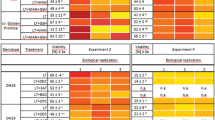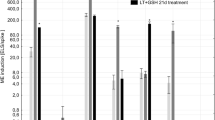Abstract
The accumulation of abscisic acid (ABA) and the activities of antioxidative enzymes along with cell metabolic activity were monitored during androgenesis induction in triticale (×Triticosecale Wittm.). Tested cultivars ‘Mieszko’ and ‘Wanad’ were selected due to their significantly different responses to androgenic induction. Significant variation was observed in respect of superoxide dismutase activity and endogenous ABA content in anthers isolated from freshly cut tillers. For both cultivars, tillers pretreatment with low temperature decreased peroxidase activity by 36%, highly accelerated respiration rate and reduced heat production. At the same time, the level of ABA in ‘Mieszko’ was increased to the level measured in ‘Wanad’. This effect was associated with higher microspore culture viability and increased stress tolerance in ‘Mieszko’. Low temperature and metabolic starvation during 4-day anther preculture did not influence activities of antioxidative enzymes, while it resulted in slight decrease in respiration rate and heat emission. The importance of these changes for effective androgenesis induction is discussed.
Similar content being viewed by others
Abbreviations
- ABA:
-
Abscisic acid
- CAT:
-
Catalase
- CPT:
-
Anthers isolated from cold pretreated tillers
- DH:
-
Doubled haploids
- DW:
-
Dry weight
- ELS:
-
Embryo-like structures
- FCT:
-
Anthers isolated from freshly cut tillers
- FDA:
-
Fluorescein diacetate
- NAA:
-
α-Naphthaleneacetic acid
- PC:
-
Precultured anthers
- PEX:
-
Peroxidase
- ROS:
-
Reactive oxygen species
- SOD:
-
Superoxide dismutase
References
Aebi H (1984) Catalase in vitro. Methods Enzymol 105:121–126
Asada K, Takahashi M (1987) Production and scavenging of active oxygen in photosynthesis. In: Kyle DJ, Osmond CB, Arntzen CJ (eds) Photoinhibition. Elsevier, Amsterdam, pp 227–287
Blokhina O, Virolainen E, Fagerstedt KV (2003) Antioxidants, oxidative damage and oxygen deprivation stress: a review. Ann Bot 91:179–194
Bradford M (1976) A rapid and sensitive method for the quantitation of microgram quantities of protein utilizing the principle of protein–dye binding. Anal Biochem 72:248–254
Dat J, Vandenabeele S, Vranová E, Van Montagu M, Inzé D, Van Breusegem F (2000) Dual action of the active oxygen species during plant stress responses. Cell Mol Life Sci 57:779–795
Davies WJ, Jones HG (eds) (1991) In: Abscisic acid physiology and biochemistry. Bio’s Scientific, Oxford UK, pp 63–77
Devaux P, Hou L, Ullrich SE, Huang Z, Kleinhofs A (1993) Factors affecting anther culturability of recalcitrant barley genotypes. Plant Cell Rep 13:32–36
Dunwell JM, Francis RJ, Powell W (1987) Anther culture of Hordeum vulgare L.: a genetic study of microspore callus production and differentiation. Theor Appl Genet 74:60–64
Forster BP, Thomas WTB (2003) Doubled haploids in genetic mapping and genomics. In: Maluszynski M, Kasha KJ, Forster BP, Szarejko I (eds) Doubled haploid production in crop plants. A manual. Kluwer Acad. Publ., Dordrecht/Boston/London, pp 367–390
Foyer CH (2002) The contribution of photosynthetic oxygen metabolism to oxidative stress in plants. In: Inzé D, Van Montagu M (eds) Oxidative stress in plants. Taylor and Francis, pp 33–68
Gorbunova VJ, Kruglova NN (1996) Genetical determination of cereal androgenesis in vitro: hormonal aspects. In: Abstracts of the 14th international congress of sexual plant reproduction, Lorne, 18–23 February 1996, p 146
Gorbunova VJ, Kruglova NN, Abramov SN (2001) The induction of androgenesis in vitro in spring soft wheat. Balance of exogenus and endogenous phytohormones. Biol Bull 28(1):25–30
Gu HH, Hagberg P, Zhou WJ (2004) Cold pretreatment enhances microspore embryogenesis in oilseed rape (Brassica napus L.). Plant Growth Reg 42:137–143
Guzman M, Arias FJZ (2000) Increasing anther culture efficiency in rice (Oryza sativa L.) using anthers from ratooned plants. Plant Sci 151:107–114
Hou L, Ullrich SE, Kleinhofs A, Stiff CM (1993) Improvement of anther culture methods for doubled haploid production in barley breeding. Plant Cell Rep 12:334–338
Hu TC, Ziauddin A, Simion E, Kasha KJ (1995) Isolated microspore culture of wheat (Triticum aestivum L.) in a defined media: I. Effects of pretreatment, isolation methods and hormones. In Vitro Cell Dev Biol 31:79–83
Imamura J, Harada H (1980) Effects of abscisic acid and water stress on the embryo and plantlet production in anther culture of Nicotiana tabacum cv. Samsun Z Pflanzenphysiol 100:285–289
Immonen S, Anttila H (1999) Cold pretreatment to enhance green plant regeneration from rye anther culture. Plant Cell Tiss Org Cult 57:121–127
Immonen S, Robinson J (2000) Stress treatments and ficoll for improving green plant regeneration in triticale anther culture. Plant Sci 150:77–84
Jähne A, Lörz H (1995) Cereal microspore culture. Plant Sci 109:1–12
Kyo M, Harada H (1986) Control of the developmental pathway of tobacco pollen in vitro. Planta 168:427–432
Leipner J, Fracheboud Y, Stamp P (1999) Effect of growing season on the photosynthetic apparatus and leaf antioxidative defences in two maize genotypes of different chilling tolerance. Environ Exp Bot 42:129–139
Lück H (1962) Katalase, Peroxydase, Reduktasen, Saccharase, Xanthinoxydase. In: Bergmeyer HU (ed) Methoden der enzymatischen Analyse. Verlag Chemie, Weinheim/Bergstraße, pp 895–897
Ma R, Guo Y-D, Pulli S (2004) Comparison of anther and microspore culture in the embryogenesis and regeneration of rye (Secale cereale). Plant Cell Tiss Org Cult 76:147–157
McCord JM, Fridovich I (1969) Superoxide dismutase: an enzymic function for erythrocuprein (hemocuprein). J Biol Chem 244:6049–6055
Mittler R (2002) Oxidative stress, antioxidants and stress tolerance. Trends Plant Sci 7(9):405–410
Mittler R, Vanderauwera S, Gollery M, Van Breusegem F (2004) Reactive oxygen gene network of plants. Trends Plant Sci 9(10):490–498
Pauk J, Puolimatka M, Tóth KL, Monostori T (2000) In vitro androgenesis of triticale in isolated microspore culture. Plant Cell Tiss Org Cult 61:221–229
Płażek A (2002) Physiological aspects of cold or ozone induced cross tolerance of barley (Hordeum vulgare L.), meadow fescue (Festuca pratensis Huds.) and rapeseed (Brassica napus L.) to biotic stress. Habilitation thesis, Agriculture University, Kraków, pp 68–82
Ponitka A, Ślusarkiewicz-Jarzina A, Wędzony M, Marcińska I, Woźna J (1999) The influence of various in vitro culture conditions on androgenic embryo induction and plant regeneration from hexaploid triticale (×Triticosecale Wittm.) anther culture. J Appl Genet 40(3):165–170
Powell W (1990) Environmental and genetical aspects of pollen embryogenesis. In: Bajaj VPS (ed) Haploids in crop improvement. I. Biotechnology in agriculture and forestry, vol 12. Springer-Verlag, Berlin, pp 45–65
Prasad TK, Anderson MD, Martin BA, Steward RC (1994) Evidence for chilling-induced oxidative stress in maize seedlings and a regulatory role for hydrogen peroxide. Plant Cell 6:65–74
Ritala A, Mannonen L, Osman-Caldentey K-M (2001) Factors affecting the regeneration capacity of isolated barley microspore (Hordeum vulgare L.). Plant Cell Rep 20:403–407
Ryöppy PH (1997) Haploidy in triticale. In: Jain SM, Sopory SK, Veilleux RE (eds) In vitro haploid production in higher plants, vol 4. Springer, Berlin Heidelberg, pp 117–131
Sato S, Katoh N, Iwai S, Hagimori M (2002) Effect of low temperature pretreatment of buds or inflorescence on isolated microspore culture in Brassica rapa (syn. B. campestris). Breed Sci 52:23–26
Schumann G (1990) In vitro production of haploids in triticale. In: Bajaj YPS (ed) Biotechnology in agriculture and forestry, wheat, vol 13. Springer-Verlag, Berlin Heidelberg, pp 383–402
Shim YS, Kasha KJ (2003) Barley microspore transformation protocol by biolistic gun. In: Maluszynski M, Kasha KJ, Forster BP, Szarejko I (eds) Doubled haploid production in crop plants. A manual. Kluwer Acad. Publ., Dordrecht/Boston/London, pp 363–367
Seppänen MM, Fagerstedt K (2000) The role of superoxide dismutase activity in response to cold acclimation in potato. Physiol Plant 108:279–285
Szarejko I, Forster BP (2007) Doubled haploidy and induced mutation. Euphytica 158:359–370
Tenhola-Roininen T, Tanhuanpää P, Immonen S (2005) The effect of cold and heat treatments on the anther culture response of diverse rye genotypes. Euphytica 145:1–9
Touraev A, Vicente O, Heberle-Bors E (1997) Initiation of microspore embryogenesis by stress. Trends Plant Sci 2(8):297–302
Touraev A, Tashpulatov A, Indrianto A, Barinova J, Katholnigg H, Akimcheva S, Ribarits A, Voronin V, Zhexsembekova M, Heberle-Bors E (2000) Fundamental aspects of microspore embryogenesis. Proc COST Action 824, “Biotechnological approaches for utilisation of gametic cells” Bled, Slovenia 1–5 July 2000, pp 205–214
Tsang EW, Bowler C, Herouart D, Van Camp W, Inzé D (1991) Differential regulation of superoxide dismutases in plants exposed to environmental stress. Plant Cell 3:783–792
Van Bergen S, Kottenhagen MJ, Van Der Meulen RM, Wang M (1999) The role of abscisic acid in induction of androgenesis: a comparative study between Hordeum vulgare L. cvs. Igri and Digger. J Plant Growth Regul 18:135–143
Walker-Simmons MK, Abrams SR (1991) Use of ABA immunoassays. In: Davies WJ, Jones HG (eds) Abscisic acid, physiology and biochemistry. Bios Scientific Publishers, Oxford, pp 53–63
Wang M, Oppedijk BJ, Lu X, Van Duijn B, Schilperoort RA (1996) Apoptosis in barley aleurone during germination and its inhibition by abscisic acid. Plant Mol Biol 32:1125–1134
Wang M, Hoekstra S, Van Bergen S, Lamers GEM, Oppedijk BJ, Van Der Heijden MW, De Priester W, Schilperoort RA (1999) Apoptosis in developing anthers and the role of ABA in this process during androgenesis in Hordeum vulgare L. Plant Mol Biol 39:489–501
Wang M, Van Bergen S, Van Duijn B (2000) Insights into a key developmental switch and its importance for efficient plant breeding. Plant Physiol 124:523–530
Zhuang JJ, Xu J (1983) Increasing differentiation frequencies in wheat pollen callus. In: Hu H, Vega MR (eds) Cell and tissue culture techniques for cereal crop improvement. Science Press, Beijing, p 431
Zoriniants S, Tashpulatov AS, Heberle-Bors E, Touraev A (2005) The role of stress in the induction of haploid microspore embryogenesis. In: Palmer CE (ed) Haploids in crop improvements. II. Springer-Verlag, Berlin Heidelberg New York, pp 35–52
Acknowledgement
The research was supported by the project KBN23/E189/SPB/COST/P06/Dz585/2002-2005.
Author information
Authors and Affiliations
Corresponding author
Rights and permissions
About this article
Cite this article
Żur, I., Dubas, E., Golemiec, E. et al. Stress-induced changes important for effective androgenic induction in isolated microspore culture of triticale (×Triticosecale Wittm.). Plant Cell Tiss Organ Cult 94, 319–328 (2008). https://doi.org/10.1007/s11240-008-9360-6
Received:
Accepted:
Published:
Issue Date:
DOI: https://doi.org/10.1007/s11240-008-9360-6




